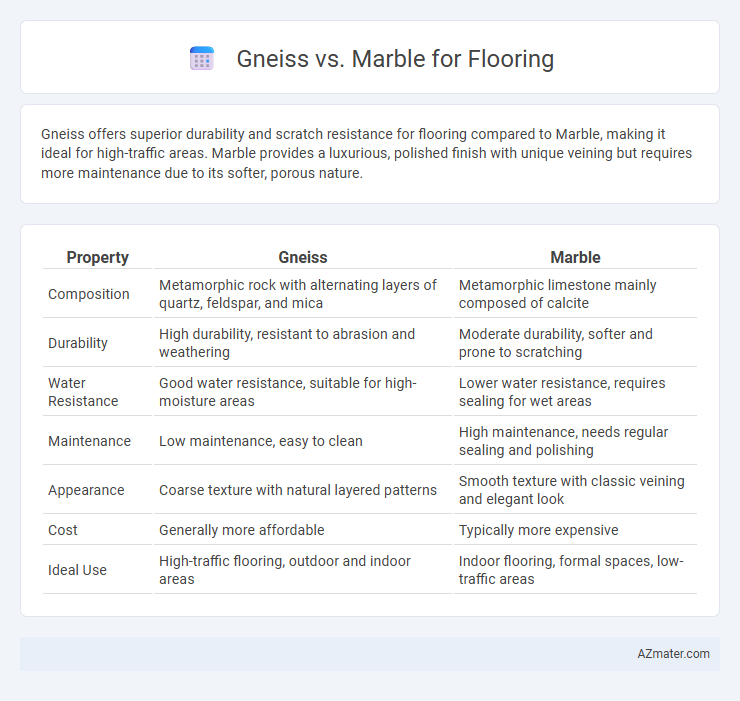Gneiss offers superior durability and scratch resistance for flooring compared to Marble, making it ideal for high-traffic areas. Marble provides a luxurious, polished finish with unique veining but requires more maintenance due to its softer, porous nature.
Table of Comparison
| Property | Gneiss | Marble |
|---|---|---|
| Composition | Metamorphic rock with alternating layers of quartz, feldspar, and mica | Metamorphic limestone mainly composed of calcite |
| Durability | High durability, resistant to abrasion and weathering | Moderate durability, softer and prone to scratching |
| Water Resistance | Good water resistance, suitable for high-moisture areas | Lower water resistance, requires sealing for wet areas |
| Maintenance | Low maintenance, easy to clean | High maintenance, needs regular sealing and polishing |
| Appearance | Coarse texture with natural layered patterns | Smooth texture with classic veining and elegant look |
| Cost | Generally more affordable | Typically more expensive |
| Ideal Use | High-traffic flooring, outdoor and indoor areas | Indoor flooring, formal spaces, low-traffic areas |
Introduction to Gneiss and Marble Flooring
Gneiss flooring offers exceptional durability and a unique, banded appearance created by its metamorphic origin, making it an excellent choice for high-traffic areas. Marble flooring is prized for its elegant, smooth texture and wide range of color variations, due to its calcite composition, enhancing the aesthetic appeal of interiors. Both materials provide distinctive natural stone options that combine strength with artistic beauty for residential and commercial spaces.
Geological Origins and Formation
Gneiss, a metamorphic rock formed from high-grade regional metamorphism of granite or sedimentary rock, displays distinct banding due to mineral segregation under intense heat and pressure. Marble originates from the recrystallization of limestone, experiencing low to medium-grade metamorphism that transforms calcite into interlocking crystals, giving it a smooth, often veined appearance. The geological formation processes of gneiss and marble influence their hardness, texture, and durability, making gneiss typically more resistant to wear and marble prized for its elegant finish in flooring applications.
Physical Appearance and Aesthetic Qualities
Gneiss flooring exhibits a coarse-grained texture with banded patterns of varying mineral colors, offering a natural, rugged aesthetic ideal for rustic or contemporary interiors. Marble flooring features a smooth, polished surface with characteristic veining in hues like white, black, or green, creating an elegant and luxurious ambiance. Both stones provide distinct visual appeal, with gneiss emphasizing earthiness and durability, while marble highlights sophistication and timeless beauty.
Durability and Hardness Comparison
Gneiss is significantly more durable and harder than marble, making it a better choice for high-traffic flooring areas due to its resistance to scratching and chipping. Marble, while elegant and softer with a Mohs hardness of about 3-5, is more prone to etching and wear, requiring more maintenance to preserve its polished surface. The foliated texture of gneiss, combined with its quartz and feldspar content, contributes to its superior strength and long-lasting performance in flooring applications.
Water and Stain Resistance Properties
Gneiss exhibits higher water and stain resistance compared to marble due to its dense, granular structure, making it ideal for areas prone to moisture exposure. Marble's porous composition absorbs liquids more readily, increasing the risk of staining and damage from spills and humidity. Proper sealing can enhance both stones' durability, but gneiss generally requires less maintenance to maintain its aesthetic appeal in wet or high-traffic environments.
Maintenance and Cleaning Requirements
Gneiss flooring requires minimal maintenance due to its dense, hard composition, making it more resistant to scratches and stains than marble. Marble demands more frequent cleaning with pH-neutral products to avoid etching and dullness, as well as periodic sealing to maintain its polished appearance. Both stones benefit from regular sweeping and prompt spill cleanup to preserve their surface integrity and longevity.
Cost and Installation Differences
Gneiss flooring typically costs between $5 and $15 per square foot, making it more affordable than marble, which ranges from $10 to $30 per square foot due to its luxury appeal. Installation of gneiss is generally easier and less labor-intensive because of its durability and resistance to chipping, while marble requires skilled labor for cutting and sealing to prevent damage from moisture and stains. Choosing between the two depends on budget constraints and willingness to invest in professional installation for marble's maintenance and aesthetic benefits.
Environmental Impact and Sustainability
Gneiss flooring is more environmentally sustainable than marble due to its abundant availability and less intensive quarrying process, which reduces habitat disruption and energy consumption. Marble quarrying often results in higher carbon emissions and generates significant waste, impacting ecosystems negatively. Choosing gneiss supports sustainable construction practices by minimizing environmental footprint and promoting resource efficiency.
Ideal Applications and Usage Areas
Gneiss offers exceptional durability and resistance to wear, making it ideal for high-traffic areas such as hallways, kitchens, and commercial spaces, where long-lasting flooring is essential. Marble, prized for its elegant appearance and smooth texture, is best suited for low-traffic areas like bathrooms, living rooms, and decorative installations where aesthetic appeal takes precedence over heavy use. Both natural stones provide unique textures and color variations, but choosing Gneiss or Marble depends primarily on the balance between durability requirements and desired visual impact in flooring applications.
Pros and Cons: Gneiss vs Marble Flooring
Gneiss flooring offers exceptional durability and resistance to scratches and stains, making it ideal for high-traffic areas, while marble flooring provides a luxurious, elegant appearance with unique veining patterns that enhance interior aesthetics. Gneiss is more heat-resistant and less porous than marble, resulting in lower maintenance requirements and better suitability for moisture-prone environments. Marble, although more visually striking, is softer and prone to etching and staining, requiring regular sealing and careful upkeep to maintain its pristine look.

Infographic: Gneiss vs Marble for Flooring
 azmater.com
azmater.com